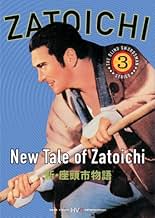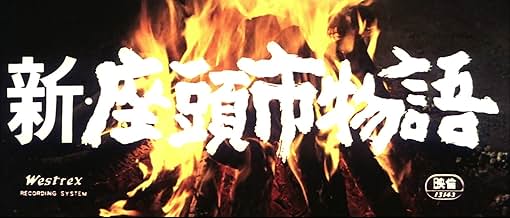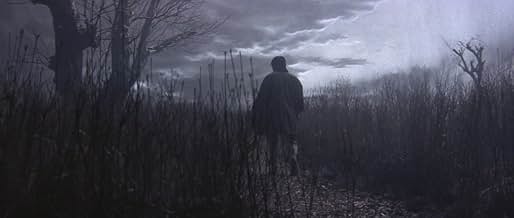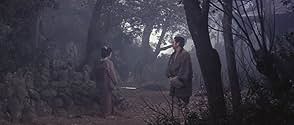La légende de Zatoïchi - Un nouveau voyage
Original title: Shin Zatôichi monogatari
IMDb RATING
7.3/10
2.5K
YOUR RATING
Wishing to find peace, Zatoichi travels to his old village but only finds trouble when he ends up in a love triangle and finds old scores have followed him home.Wishing to find peace, Zatoichi travels to his old village but only finds trouble when he ends up in a love triangle and finds old scores have followed him home.Wishing to find peace, Zatoichi travels to his old village but only finds trouble when he ends up in a love triangle and finds old scores have followed him home.
- Director
- Writers
- Stars
- Awards
- 1 nomination total
- Director
- Writers
- All cast & crew
- Production, box office & more at IMDbPro
Featured reviews
The following review is an extract from the book "Shintaro Katsu´s Zatoichi: Complete guide to all movies", which is now available on Amazon.
In this third part of the Zatoichi saga, the protagonist (played by Shintaro Katsu) wants to change some things of his past, leave behind the Yakuza and correct his mistakes, returning to the town where he grew up. On the way he meets a former schoolmate, who acts as a musician singing and playing the shamisen. His childhood friend is with his wife and young son. The four stay in an inn for the night, and as Ichi sings a song with the shamisen, the place is assaulted by a gang of hooded thieves. So as not to endanger his friends and other guests, Zatoichi does not resist for the time being, and prefers the criminals to believe that he is nothing more than a poor, blind masseur (when in reality he is a prodigious swordsman, even though he lacks a sense of vision).
(...)
The third part of the Zatoichi saga has a slight philosophical background that is somewhat reminiscent of Taoism (the action of non-doing, or wu-wei). Zatoichi's apparent passivity towards Kanbei's brother, who wants revenge, provokes new reactions and events. The attitude of the protagonist is to renounce his past life and become a new man by returning to the origins, to the village where he grew up. There he will discover with disappointment that the one who trained him in the arts of fencing, the one to whom he owes his knowledge in the handling of the sword, far from being a venerable master, is actually a despot who does not hesitate to mercilessly murder unarmed people and in inferior conditions, either as a consequence of his uncontrollable anger or simply for money and material goods, in cold blood. Much more noble and honorable is the young yakuza. After verifying this, Zatoichi decides to continue his wandering life, renounces family and marriage and continues on his way with the firm intention of never returning to his village.
In this third part of the Zatoichi saga, the protagonist (played by Shintaro Katsu) wants to change some things of his past, leave behind the Yakuza and correct his mistakes, returning to the town where he grew up. On the way he meets a former schoolmate, who acts as a musician singing and playing the shamisen. His childhood friend is with his wife and young son. The four stay in an inn for the night, and as Ichi sings a song with the shamisen, the place is assaulted by a gang of hooded thieves. So as not to endanger his friends and other guests, Zatoichi does not resist for the time being, and prefers the criminals to believe that he is nothing more than a poor, blind masseur (when in reality he is a prodigious swordsman, even though he lacks a sense of vision).
(...)
The third part of the Zatoichi saga has a slight philosophical background that is somewhat reminiscent of Taoism (the action of non-doing, or wu-wei). Zatoichi's apparent passivity towards Kanbei's brother, who wants revenge, provokes new reactions and events. The attitude of the protagonist is to renounce his past life and become a new man by returning to the origins, to the village where he grew up. There he will discover with disappointment that the one who trained him in the arts of fencing, the one to whom he owes his knowledge in the handling of the sword, far from being a venerable master, is actually a despot who does not hesitate to mercilessly murder unarmed people and in inferior conditions, either as a consequence of his uncontrollable anger or simply for money and material goods, in cold blood. Much more noble and honorable is the young yakuza. After verifying this, Zatoichi decides to continue his wandering life, renounces family and marriage and continues on his way with the firm intention of never returning to his village.
'New Tale Of Zatoichi (1963)' sees its eponymous blind swordsman/masseur return to the town in which he was trained, followed by his reputation and the repercussions of the prior movie's events. Once again, it's a relatively meditative character study at heart. With flashes of fast-paced, decisive action and a background plot focused on a kidnapping, the picture ebbs and flows until it reaches its melancholic yet explosive finale. It's a little bit scatterbrained and doesn't have the strongest of central threads; the closest thing to a proper through-line is probably an ill-fated romance that brings out the best in Zatoichi but the worst in his master. In general, the movie is enjoyable. Plus, its shift to colour has little impact on its overall look and feel. Even if it isn't as solid as its two predecessors, it's still well-made and engaging. 7/10
New Tale of Zatoichi is the third entry in the franchise centered around the skilled blind swordsman with the strong moral compass. It's also the first movie of the franchise to be shot in color. However, it's also the weakest part of the franchise thus far but still an above average experience. Zatoichi is hunted down by the family of a yakuza he killed in the previous film when he is unexpectedly saved from trouble by his former master. He agrees to stay with his former master and his younger sister and also visits his solitary grandmother. What seems to be a joyous reunion soon turns sour when Zatoichi realizes how his master has changed for the worst. His former master tries to marry his sister to a man whom she doesn't love, kills unarmed people for unjustified reasons and cooperates with a ruthless gang of criminals by taking advantage of his pupils' rich parents. Zatoichi can't ignore the truth and ends up challenging his former master to a decisive duel.
The third installment of the Zatoichi franchise must be separated into two parts. The first half of the movie is quite pointless and could also be told in five minutes or less. We follow Zatoichi traveling across rural Japan and meeting former friends and foes. The movie plods along and is only average at best because of an imprecisely meandering plot. Up to that point, the film could be considered an at best average slice of life or road movie. Things however improve by a few notches when his former master's sister proposes to Zatoichi. From then on, the characters are developed in depth, philosophical topics such as dishonor and honor are discussed and the movie skillfully mixes beautiful fight choreography with a tragic love story. The second half of the film is the most emotional passage of the franchise as we witness Zatoichi's desperate quest for love, peace of mind and renaissance which he simply cannot find as he is constantly challenged, judged and haunted by the demons of his past.
In the end, despite being the least interesting part of the franchise thus far, New Tale of Zatoichi is still worth your attention because of an emotional second half that pardons for a plodding first half. The movie stands out with a sad, melancholy and gloomy touch and makes the viewer empathize with the haunted swordsman more than ever before. Fans of the franchise should definitely watch this film while occasional martial arts fans should rather try out the first installment, The Tale of Zatoichi.
The third installment of the Zatoichi franchise must be separated into two parts. The first half of the movie is quite pointless and could also be told in five minutes or less. We follow Zatoichi traveling across rural Japan and meeting former friends and foes. The movie plods along and is only average at best because of an imprecisely meandering plot. Up to that point, the film could be considered an at best average slice of life or road movie. Things however improve by a few notches when his former master's sister proposes to Zatoichi. From then on, the characters are developed in depth, philosophical topics such as dishonor and honor are discussed and the movie skillfully mixes beautiful fight choreography with a tragic love story. The second half of the film is the most emotional passage of the franchise as we witness Zatoichi's desperate quest for love, peace of mind and renaissance which he simply cannot find as he is constantly challenged, judged and haunted by the demons of his past.
In the end, despite being the least interesting part of the franchise thus far, New Tale of Zatoichi is still worth your attention because of an emotional second half that pardons for a plodding first half. The movie stands out with a sad, melancholy and gloomy touch and makes the viewer empathize with the haunted swordsman more than ever before. Fans of the franchise should definitely watch this film while occasional martial arts fans should rather try out the first installment, The Tale of Zatoichi.
Daiei's logo is impressively shown for the first time in colour, in this, the third Zatoichi adventure, released only five months after the second film, and eleven months after the original.
Well photographed in full colour, it's another beautiful looking film, and the director, and cinematographer, both know how to effectively use bright, vivid colours, contrasted with subdued tones, as the second film's villain's brother tries to avenge his death, while Ichi is dealing with a ruthless gang of thugs, but I must admit that I did prefer the monochromatic photography of the first two installments.
Well photographed in full colour, it's another beautiful looking film, and the director, and cinematographer, both know how to effectively use bright, vivid colours, contrasted with subdued tones, as the second film's villain's brother tries to avenge his death, while Ichi is dealing with a ruthless gang of thugs, but I must admit that I did prefer the monochromatic photography of the first two installments.
This is more boring and more predictable than the other Zatoichi movies I've seen so far. And, I only mean the ones with Shintarô Katsu, excluding the one
with Takeshi Kitano. However, it has some good moments, still worth seeing. Mikiko Tsubouchi is not as beautiful as the actresses in other Zatoichi movies,
but she has her own charm.
Did you know
- TriviaThis is the first Zatoichi movie to be shot in colour.
- ConnectionsFeatured in Best in Action: 1963 (2019)
- How long is New Tale of Zatoichi?Powered by Alexa
Details
- Release date
- Country of origin
- Language
- Also known as
- New Tale of Zatoichi
- Production company
- See more company credits at IMDbPro
- Runtime
- 1h 31m(91 min)
- Aspect ratio
- 2.35 : 1
Contribute to this page
Suggest an edit or add missing content



























